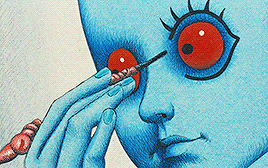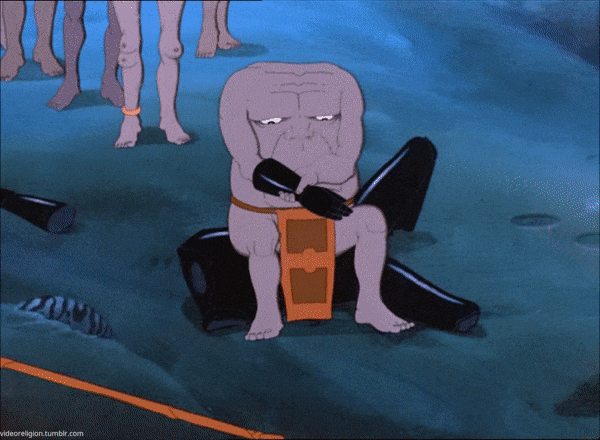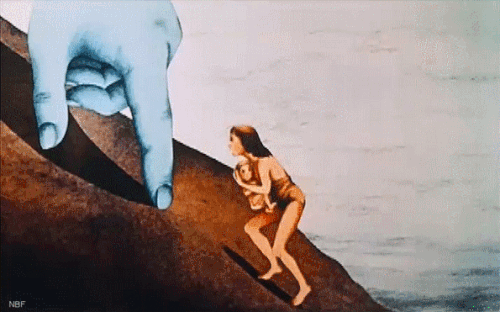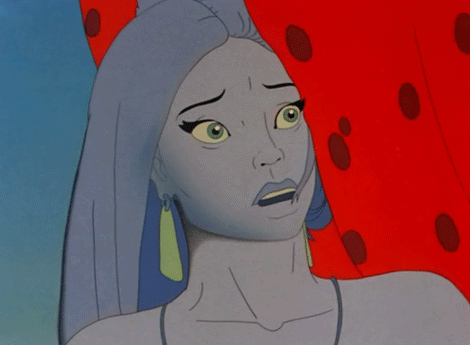originally posted at https://canmom.tumblr.com/post/676463...
Bonjour mes amis! C'est la soirée animations!

French animation - it’s been a while, hasn’t it? Tonight we’re going to be returning to someone we haven’t seen since Animation Night 71 - Moebius - a director who really lives up to the French reputation for ‘weird’ and ‘arty’ in the best way. That is, we’re going to watch the two remaining films of the renowned René Laloux - Fantastic Planet (La Planète sauvage) (1973) and Gandahar (1987).

I feel like these gifs alone are probably more than sufficient reason to watch these films, but if the images aren’t enough to entice you alone, let’s add a little historical context!
So, what can we find out about René Laloux? The basic facts are easy to find: most biographies will tell you that Laloux was born 1929, attended art school in Paris, and worked in the ad industry for a while before getting a job at a psychiatric institution where he made shadow plays for the patients, and eventually created a cutout-animation short film The Monkey’s Teeth.
For a more detailed account, a little digging turns up this essay by Craig Keller in 2006. Much too long to quote in full, it relates how René enjoyed a comfortable childhood until - of course - the outbreak of WWII, during which René’s dad left to fight the Nazis with the French Resistance. At this point, he took up an apprenticeship in woodcarving, and started learning about the arts:
Motivated and curious, he set out to supplement the family income, and thus took on at age thirteen an apprenticeship in wood-carving beneath an uncle who specialised in creating Gothic-style representations of the Pietà . One might earmark this stint as Laloux’s first commercial foray into the figurative arts, but he is likely to have begun to truly hone his expressive talents by attending a series of evening art classes each day after the close of the studio. The requisite cultivation of personal tastes would follow in the immediate post-war period when, reveling in everything up for offer in this city reborn, Laloux discovered theatre, literature, painting, — and, of course, the Cinémathèque.

In the years after leaving home, he lived a chaotic life, in which he practised puppetry while working a range of jobs including woodcarver, bank clerk, and plastic bag manufacture. In the middle of this was a period of compulsory military service in Austria, which he despised.
The psychiatric institution mentioned above turns out to be La Borde Psychiatric Clinic in Cour-Cheverny. Keller writes that this was at the time going through an experiment in how such facilities were run, which played a part inspiring the theories of - guess who - Felix Guattari, at the time a doctor at the clinic!
La Borde’s system, by contrast, favoured an atmosphere that evoked less a Foucauldian vision of servitude and control than a borderless extension of the outside world itself: no locked doors, a regular schedule of group activities for patients, and a setting of expansive green that circled the main residence, a handsome assemblage of château-like quarters. Patients at La Borde (present in large part to receive treatment for depression) were unconfined, free to roam the grounds as they would and, as part of an overarching communal spirit, take part in the decision-making process with regard to the logistics of life at the clinic.
Yeah, wasn’t expecting Guattari to show up in this story. I admit, when I read that he worked at a psychiatric institution I was a bit like, uh-oh, but actually it seems like it was a lot better than all that…
Given René Laloux’s terror of fascism grand and quotidian (and his understanding that there is little use in differentiating between the two degrees), he seemed to have found in his employment at La Borde a perfect calling. Oury and Guattari were likewise pleased with the artistic spirit and sense of generosity that Laloux graced upon the patients; his workshops devoted to painting and shadow-puppetry were many residents’ favourite pastimes.
Laloux started looking into film at this time, working with the patients at the institution. Their first two films were very experimental…
- Tic-tac (Tick-Tock, 1957), which documented their shadow puppetry - unfortunately I can’t embed this but you can watch it here.
- Les Achalunés (The Achalunés, 1958), which used a creative technique with pieces of coloured glass filmed behind tracing paper - available on the same site
There was also an attempt to create a film to the music of Pierre Schafer, but this fell through. Then, when news of Tic-tac getting purchased for TV broadcast reached the hospital, Laloux and the excited patients set out to make the film that became known as Laloux’s debut, Les Dents du singe (The Monkey’s Teeth, 1960):
This wordless, dreamlike, deliberately paced film depicts a dentist pulling teeth from an anaesthatised patient, who chases after the dentist as a monkey rides around on a bike; it’s full of surreal transformations and varied styles. (I admit the patient at the beginning having his teeth pulled puts me a little bit in mind of Salad Fingers); eventually the monkey reaches the dentist and pulls his teeth in turn, transplanting them to the original patient. Edit: I found a version with the making-of part, but let me quote anyway:
The opening of the film details in several minutes of black-and-white documentary footage the participants at work: seated around tables, they puff on Gitanes, discuss the storyline and make sketches. A narrator informs the viewer that each patient had devised a “récit” for a single character who would remain “his” or “hers” throughout the course of development, before a consensus could be reached with regard to which narrative threads should be woven into the final work. Unfortunately, the framework established by the film’s prologue stops short of documenting the most laborious part of production: the animation process. When preparation of the scenario and artwork had been completed, Laloux worked with Julien Pappé to instill life in the elements — nothing more complex than articulated paper cut-outs — by photographing them frame-by-frame with a camera positioned over an illuminated animation stand. Pleased with the relative speed afforded by this method of work, Laloux continued for years to experiment with paper cut-outs, developing the style into something of an artistic — and artisanal — signature.
This all definitely made an impression, earning Laloux the Prix de Emile Cohl, a prestigious prize for French animation. The awards ceremony threw him into contact with Hara-Kiri artist Roland Topor - they got to express their mutual admiration and soon, with Laloux leaving the clinic, they set to collaborating on a short film - Les Temps morts. Here’s how Keller describes the work…
Les Temps morts (Dead Times, 1964) is a narrated-poetic-animated essay that explores through archival documentary footage and inky, black-and-white drawings by Topor the atrocities of war and, as inverse to André Malraux, man’s destiny. The overtly philosophical (and justifiably cynical) tone of the film certainly makes the work stand apart from the vast majority of animated cinema; seen from a 21st century vantage, its mood and visual style (Topor’s cross-hatching technique essentially embodies “conflict”) seem to anticipate the tone of the modern graphic novel.
You can watch it here:
It does feel rather like something you might see at Annecy today, doesn’t it? But this is the OG annecycore - there wasn’t much like it in the 60s! Topor’s drawings of mutilated bodies, piles of limbs, and general strangely placid carnage call to mind The Wall two decades later. In terms of animation, it’s almost entirely a camera panning over static images, with occasional cutout animation, to a drily cynical voiceover describing the many many ways humans make death a routine part of our lives. The music is a suitably forlorn accompaniment.
Not long after, Laloux and Topor continued their collaboration on another, more narrative project: Les Escargots (The Snails, 1965), which perhaps was his first big step towards the surreal sci-fi he’d eventually become known for. A farmer struggles to raise his crops through a series of unorthodox means including magnets and balloons, and meets unexpected success by using his own tears, only to be menaced by enormous snails… who soon die out, leaving a land covered in enormous shells.
The film moves from heavily hatched ink drawings to paintings, animated once more with cutout animation.
This, too, was successful, and Laloux and Topor got the bug to make a feature film, which would become Laloux’s most famous work. For a story, they chose Oms en série (Oms in Series, 1957) by French science fiction author Stefan Wul, in which human Oms are enslaved to aliens. Of course, such a feat was way outside the scope of just two artists; Topor refused to do more than pre-production to define the look of the film, so Laloux turned to… the Czech republic, which has its own very interesting tradition of animation which we must cover on here! He enlisted Josef Kabrt to handle the technical animation work, moving from the old jointed paper cutouts to something closer to traditional cel animation (but with cutouts instead of cels).
Kabrt, for his part, brought to the project a sharp technical instinct — he had steered Laloux toward the idea to animate the film with discrete, un-jointed elements — that the French filmmaker found representative of the high standards of Czech animation. This impression, coupled with the political “thaw” then underway in Czechoslovakia, influenced Laloux and his producers to undertake the long project as a French-Czech co-production and, in doing so, alleviate some of the financial burden necessitated by the film.
The production didn’t go entirely smoothly. At one point the Czech producers considered essentially staging a coup, removing Laloux to make a more nationalist film with Kabrt as director - fortunately this amounted to nothing and the film, now titled La Planète sauvage in French and Divoká planeta in Czech (literally The Wild Planet, but better known in English as Fantastic Planet) dropped in 1973 to enormous acclaim.

The film tells the story of the rebellion of the enslaved humanoid Oms against the giant, oblivious Draags, who fancy themselves an enlightened ascended race spending their lives in a blissed out state. But when an Om manages to escape with a tutorial headset containing the secrets of Draag technology, the Oms rise up, shocking the Draags who saw them as domesticated animals. The rebellion provokes a campaign of genocidal extermination as the Oms race to escape the planet on rockets.
Keller interprets this film as being, in some significant part, a metaphor for mind-expanding states like drugs and sex:
It’s not going far at all to uncover in La Planète sauvage barely veiled references to the benefits of getting high — whether that means taking drugs (cf. the vapour-inhalation, and all the shape-shifting that transpires before dilating eyes), exercising the libido (cf. the cock-shaped rockets, and the headless — therefore ego-resistant? — statues used in the extraplanetary mating ritual), or, simply and literally, meditating transcendentally. (…) It’s probably to La Planète’s merits as, above all, an “experiential aid”, that the film avoids the sci-fi cliché of a proxied, connect-the-dots allegory, and settles instead on presenting a broad, even simplistic, message or moral ideal — “the mind’s true liberation,” to quote The Fifth Dimension — in a mind-blowingly original way. In Laloux’s film, style itself lends truth to beauty, draws dignity out of the easy lesson. (In fewer words, and to quote another luminary of the zeitgeist, “the medium is the message.”)
Laloux would make one final collaboration with Topor, a short film titled Le Jeu (The Game, 1975).
Keller’s story ends there (with some praise for the elements that make up the film, such as the score), but of course, Laloux had two more films in him before his life was cut short by a heart attack in 2004. One is Les Maîtres du temps (The Time Masters, 1982), a delightful film made in collaboration with the renowned comic artist Moebius which we watched back on Animation Night 71. At the time I could turn up relatively little information about the film’s production; this time I’ve been able to retrieve one small tidbit from this page:
Jacques Dercourt, one of the producers, suggested the outsourcing to PannóniaFilm in Hungary, most likely through being impressed by their JANKOVICS Marcell-directed features. It was felt that while they lacked much of the technical skill and experience of the Czech animators, their more modern style would more easily mesh with that of Mœbius — however, Laloux and Giraud himself have ever since regretted this decision, and blame the animation’s inconsistency, to an extent, on cultural divisions between themselves and the Hungarians.
As that quote suggests, Laloux did not regard the film as a success - but he collaborated with Moebius one more time, on a short film La Maîtrise de la qualité (Quality Control, 1984), though regrettably I don’t seem to be able to find this one anywhere.

Following this collaboration, it seems Laloux stepped back from feature films for a bit, instead directing three episodes for the 1984 short science fiction film collection series De l'autre côté (On the Other Side). Here he began a collaboration with another talented French comic artist from Les Humanoïdes Associés, Philippe Cazaumayou, better known as Caza - you can check out some of his work here. I don’t have information on how Laloux and Caza met, but at least one of their segments, La Prisonnière (The Prisoner, 1988), available here:
(Unfortunately the falling slow absolutely kills the compression on this one.)
It’s full of that distinctive Humanoïdes drawing style, with austere, unusual architecture, super-defined faces, and lots of hatching. The story is rather vague - it feels like just a montage of images of two bald children running through a vast city while… various rituals seem to happen. There’s quite an interesting way of painting spray from the sea.
Before long, they set out to make Laloux’s third feature film, Gandahar. This time some of the animation work was done by SEK Studio from North Korea. I wrote a bit about them back on Animation Night 20 - they’re best known for domestic North Korean animations such as Squirrel and Hedgehog, but known to take outsourcing work from primarily South Korean Studios, often down the outsourcing chain from Western productions.
Another collaboration with Caza, made during the production of Gandahar, adapts a French Orientalist story about a painter in the Chinese court by Marguerite Yourcenar (from her collection Nouvelles orientales (1938)). Here’s the video, though I don’t have subtitles:
Unfortunately most of the sources I might to talk about this film succumbed to link rot, so I can’t really comment on what it has to say. Apparently it had ‘the same staff arrangement’ as Gandahar, which might mean it was also the work of SEK Studio.
That at last takes us to talking about Gandahar proper. It has some real Gender Shit going on - the peaceful Gandaharians are ruled by a Council of Women led by one Queen Ambisextra, who sends the protagonist Sylvain to investigate when an army of automata called the Men of Metal attack. His quest takes him into contact with the outcast Deformed, produced by experiments of Sylvain’s people, and they form an uneasy alliance against the Men of Metal. The reason behind it all turns out to involve a rather delightfully complicated time loop and giant brain.
The film received a bad American dub, which in the hands of Harvey ‘rapist’ Weinstein and Isaac ‘serial sexual harasser’ Asimov cut most of the music of Gabriel Yared and censored all the sexual elements of the story, released under the title The Light Years. Unfortunately, it is often easier to find this dub than the original French version, and there was never a release in higher than DVD quality - although there is an interesting case here where someone managed to do an AI upscale. I am usually sceptical of AI upscaling since it often scrubs detail and artistic intent, but given just how bad the video quality of the DVD releases is, I’m prepared to give it a shot this time.
Reviewer Aliya Whitely says of Gandahar that it is more simplistic than Laloux’s other films, with weaker animation, but all the same…
Gandahar may have flaws, but the music, its playfulness with language and form, and its commitment to explore adult themes, makes it worth watching.
Sadly, perhaps in part due to the botched American release, this remains the least popular and hardest to acquire of Laloux’s films.

Although this was Laloux’s last feature film, he was set to make one more, this time with another comics artist, Patrice Sanahujas. The film, titled À l'ombre du dragon (In the Shadow of the Dragon), was set to adapt a book by Serge Brussolo. Work on the film began in 1992, but came to an abrupt end when Sanahujas succumbed to leukemia, leaving only a concept art trailer, although it would eventually be resurrected by Gandahar’s assistant director Phillippe Leclerc - it was eventually released under the title Les Enfants de la pluie (Children of the Rain) in 2003. Turtleheart, who wrote the source I’m using here, describes it as having an African-influenced aesthetic, ‘distinctly post-Kirikou’.
This left Laloux to make one final film, taking on the magical-realist children’s book L'Œil du loup (Eye of the Wolf, 1984) by Daniel Pennac. This film hit financial problems and had its runtime cut to just half an hour, and this so upset Laloux that he handed it over to Hoël Caouissin to complete; the film was finally released in 1998. You can watch a five minute trailer to it here - it has a really beautiful painted aesthetic.
Sadly, that was to be his last film. Laloux died in 2004 of a heart attack, at age 74, leaving a set of really beautiful and fascinating films whose distinctive images cast a wide influence, reaching as far as the Pikmin games - and tonight it’s time to fill in the list, at least the ones I’ve been able to acquire!
Since I need to eat and stuff, Animation Night is going to start in about an hour from this post, at 8pm UK time, in the usual place of https://twitch.tv/canmom. I would love to see you there! Laloux is one of the real legends of weird psychosexual science fiction animation and I’m excited to finally see his works~
Comments